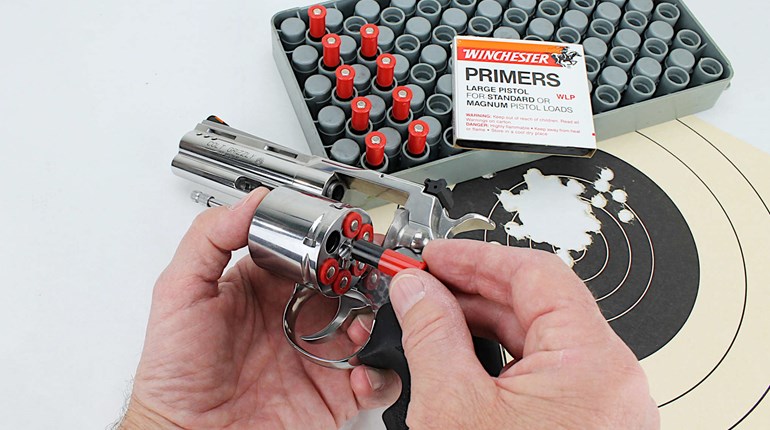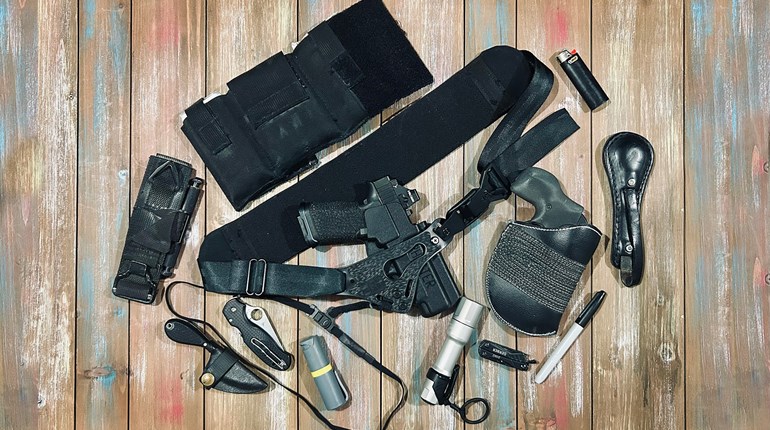
There are many levels to shooting proficiency and defensive preparedness. It can be difficult to accurately tell where we are on that journey, especially if we are new to it. To help us evaluate ourselves, let’s draw an imaginary line between a “casual shooter” who shoots guns recreationally and the shooter who is beginning to get serious about defensive pistolcraft. Below we’ll examine some indicators that one is crossing from the casual-shooter category into “serious-shooter” category. If you don’t check all these boxes, don’t sweat it, as they aren’t written on a stone tablet. These are just some general ideas of how to progress as a defensively minded armed citizen that you can use as progress markers on your journey.
Upgrading Ranges
Most people start out their shooting journey by going to the range nearest their house. Most find themselves at an indoor range attached to a gun shop or a local gun club range, and the rules are not always conducive to practicing defensive-pistol skills. For example, two very common rules at commercial and gun club ranges is “no drawing from the holster” and “no rapid fire,” typically meaning no more than one round fired per second (or even slower). For new handgun shooters just starting out, these rules are no big deal. Our initial focus needs to be on observing the basic safety rules of gunhandling, practicing proper grip, sight, and trigger management and learning to shoot precisely and accurately with a degree of consistency. All of this can be practiced at range with restrictive rules.
Eventually, however, we are going to be consistent in our safe gunhandling and fundamentals of marksmanship while standing still with gun in hand and under no time pressure, and we need to move on to additional defensive-shooting tasks. This will require finding ranges that allow drawing from the holster, shooting quickly while maintaining accuracy and even allowing movement and use of cover. Many ranges that allow this may require you to be trained or vetted by their staff before you can do so, which is prudent and well worth it to progress in our defensive pistolcraft journey. If you’ve already taken this step, congratulations on your progress! If you are at the range shooting accurately during slow, deliberate strings of fire, and are looking for the next step, then finding a range that will help you to begin drawing from the holster and shooting more quickly is a great place to start.
Take Measure of Yourself
Another mile-marker on the journey to serious self-defense-minded shooter is to begin objectively measuring your performance on the range. The first manner in which to do this can begin the day you buy your first gun, and that is to measure your accuracy. There are a myriad of specific ways to do this, but all involve using some type of standardized targets at standardized distances and tracking your progress over time. There are a variety of targets, and we can measure accuracy improvements by shooting at increasingly distant targets, or at increasingly small ones.
For example, you could take a B-8 Repair Center target and put it at 3-5 yards and shoot 10 rounds into it deliberately until you’re able to keep all rounds inside a particular scoring zone. For newer shooters it may be just trying to get all the rounds on the target and then move on to getting them inside the black portion of the scoring area. As you progress your goal might be put all rounds inside the 10-ring. Once accomplished, you can either opt for a smaller target, such as trying to keep all the rounds in the X-ring or a 2-inch circle, or you may opt to just move the whole target back to 7-10 yards and practice at that distance until you can meet a certain accuracy standard. One could also use the A-zone on an IPSC target, or the Down Zero zone on an IDPA target. The target itself is less important than a standardized target size and distance to measure our progress.

Another form of measurement is to measure the speed of your shooting. This requires a shot timer of some kind. There are free shot timer apps available for popular smart phones, but the best timers are standalone units that are a sound investment in your shooting journey. These shot timers allow you to measure the speed of your draw to first hit on a particular target size at a particular distance or measure your “split times,” or time between shots in a string of fire. When using a shot timer, we still maintain accuracy standards and prefer a slightly more deliberate hit to a lightning-fast miss. That said, to get faster we have to practice going faster, and shot timers are an indispensable tool in the serious shooter’s range bag to measure our progress.
Goal Setting
One of the surest hallmarks of a serious shooter is setting goals to pursue and mark our progress. Once we have a range where we can practice defensive skills, and the tools to measure our performance, we need to assess where we are and where we want to be. If you already have goals in your shooting performance, then you’re on your way to improvement. If not, then figure out where you are and begin setting some goals. The important aspect of goal setting is that goals be measurable. For some, they simply need to start by setting general dry-practice and live-fire practice goals. An example would be to dry-practice at home once a week, or twice a month, and go to the range for a structured practice session once every two or three months. Maybe that goal is more or less frequent than the example, but the point is to set a goal that is a realistic improvement over your current routine.
Beyond that, specific performance goals are needed. Break down specific aspects of shooting, or choose standardized drills and begin practicing them and recording how you’re doing. Then set achievable goals toward which to aspire. One staple drill is the Draw-To-First-Hit Drill. At seven yards and with the handgun holstered and the hands in a natural position, at the beep of the timer draw and shoot one round into the target (ideally an 8-inch circle of an IDPA target or the A-zone of an IPSC target). I would encourage any citizen that plans on carrying a handgun for self-defense in public strive to achieve a consistent sub-2 second draw to first hit in this drill. However, if you attempt this drill and it takes you 4 seconds to score a good hit, don’t lose heart. Just set a short-term goal of getting down to a 3.5 second time, and then 3 seconds, and so on. In the classic Bill Drill, which is the same set up the same as the previous drill except that you draw and shoot six rounds into the target, a good initial goal would be sub-5 seconds, which is a sub-2 second draw to first hit with 0.6 second splits for the follow up shots. Again, if you’re nowhere close to 5 seconds to get all your hits, then simply set intermediate goals and keep grinding closer to where you want to be. Goal setting is the mark of the serious shooter.
Conclusion
Ultimately, serious shooters intent on being well-prepared armed citizens have many habits in common and these are among the most universal. We need to find a range where we can practice defensive shooting skills. We need to measure our performance in an objective manner. We need to set goals to guide our practice and track our progress. These are the hallmarks of serious, defensively minded armed-citizens.



































